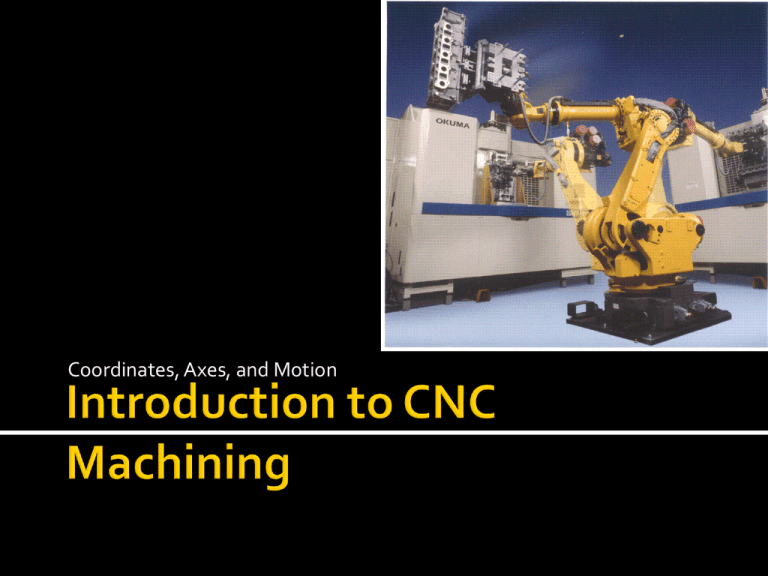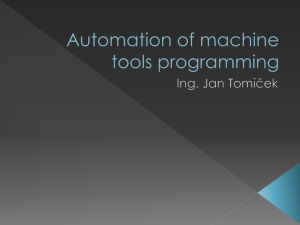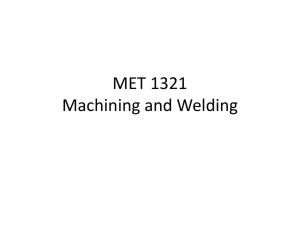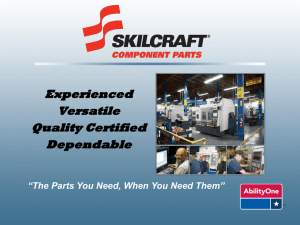Introduction to CNC Machining
advertisement

Coordinates, Axes, and Motion We’ll first learn about axis systems. Then we’ll investigate how the machines understand where to move, and the kinds of moves they can make getting there. Machining and CNC Technology by McGraw-Hill Higher Education Unless it’s a multiplexed machine with several There are 14 standard axes auxiliary rotary and linear axes,defined these nineby arethe adequate to define mostAssociation of the equipment in used Electronics Industries (EIA) industry today. for motion and position. However, for tomorrow’s manufacturing In this course we’ll study 9 of them.world, that’s another question? Machines continue to 3 Primary Axes X, Yare and Zto handle evolve asLinear central processors able more andRotary more calculations perand nanosecond, thus 3 Primary Axes A, B C more functions simultaneously. 3 Secondary Linear Axes U,V and W Machining and CNC Technology by McGraw-Hill Higher Education Whenever you are assigned to a new CNC machine, the axis set must be identified as the first order of business. Here are the sets for three common machines. Machining and CNC Technology by McGraw-Hill Higher Education It’s easy to identify the spindle, which is the Z axis or it faces Z. Then apply the Right Hand Rule by pointing your right middle finger in the positive Z direction. Your fingers and thumb then form the orthogonal axis frame (mutually at 90º) Machining and CNC Technology by McGraw-Hill Higher Education First identify the Z axis. It’s parallel to the spindle axis, and brings the work toward and away from the spindle. Pointing your middle finger in the positive Z direction, your index finger and thumb form the other positive axes. Machining and CNC Technology by McGraw-Hill Higher Education The set (my fingers) Allremain CNCinmachines use the X-Z or X-Y-Z frame, the same with each axis perpendicular to the others. orientation to each That relationship stays the same no matter how other no matter their the worldaxis set is rotated to suit the machine. orientation Toward stronger or more efficient machines manufacturers arrange the set any way convenient, but not the inter-relationship between axes. Machining and CNC Technology by McGraw-Hill Higher Education The X axis on many turning centers, is not X Slanted parallel to the floor, it slants forward. That provides easy access to the turret for setup work, Z since the machine isn’t as wide as level X axis machines. 90º Plus chips and coolants slide right off to the Thisbasin lathe’s world axis orientation is not level but it’s still an catch below. orthogonal set. Machining and CNC Technology by McGraw-Hill Higher Education Whenever a machine features a rotary axis, we identify it this way: If it rotates around a line parallel to X it’s an A axis Y it’s B Z it’s C Machining and CNC Technology by McGraw-Hill Higher Education Rotary axes can move a cutter head in an arc Or they can move the workpiece in an arc. In this film we see A and B auxiliary axes moving simultaneously with X, Y and Z, to cut this complex turbine blade. Machining and CNC Technology by McGraw-Hill Higher Education X+ Z+ To determine the direction of rotary motion, Y+ Point the thumb of your either plus or minus A,B or C, we use the Rule right hand in the direction the rotary axis’ line of ofofrotation, Thumb. X, Y or Z positive direction. It’s based on the line about which the rotary axis pivots, X, Y or Z Positive CAB direction Positive Positive direction What motion? Machining and CNC Technology by McGraw-Hill Higher Education tip ofwork, the drill isthe at origin, X0, Y0, Z0, is known In The CNC Y1.00, Z-1.00 Reference Zero (PRZ) asX2.500, the Program to the PRZ which is It’sRelative the starting point for coordinates the lower left corner on this part coordinates in the program refer their Most distance from the PRZ. For example. Machining and CNC Technology by McGraw-Hill Higher Education Occasionally we encounter the need for a different kind of coordinate. They do not refer to the PRZ but rather, to their last position. Incremental coordinates are jumps from where you are to where you wish to go next. Machining and CNC Technology by McGraw-Hill Higher Education CNC machines move their axes in five ways: Rapid Travel Linear single or multi axis straight line motion Circular motion within a single plane. Circular/Linear, also called 2 ½ dim. motion. Two axes move in an arc while the third moves in a straight line. 3-D motion few controls have the ability to move in an arc using 3 axes simultaneously. Most approximate these arcs through the power of the cam software. Machining and CNC Technology by McGraw-Hill Higher Education Trade Tip Caution! Depending on the Rapid – as fast as power of the CPU, your the machine can machine will rapid in one of twomove ways. Older butcontrollers with take an unexpected nonlinear the ability to with path! Newer controllers 16-bit or higher reduce speed microprocessors follow the operator truethrough linear motion. over-ride control. Machining and CNC Technology by McGraw-Hill Higher Education The next four motions all move one or more axes at the rate specified in the program. The differences lies in how many axes are involved, in a straight line, or arc. As motions become more complex, the CPU must handle far more calculations per second by interpolating each axes drive commands. Machining and CNC Technology by McGraw-Hill Higher Education To move axes simultaneously, to produce a constant velocity along the line A-B, say at 400 inches per minute. neither the X or Y axis will be moving at 400 IPM. They will run at lower speeds that combine to create the tool motion of 400 IPM. Machining and CNC Technology by McGraw-Hill Higher Education B Programmed Rate 400 Inches Per Minute 137.81 IPM Y Axis A 375.87 IPM, X Axis Motion Machining and CNC Technology by McGraw-Hill Higher Education The linear interpolation required the control to set each axis moving at constant values but different rates. The operator can over-ride the resultant tool motion from 0% (no movement) up to 100% or 150% on some machines. Machining and CNC Technology by McGraw-Hill Higher Education For arc motion at feed rate, the controller is also interpolating as with linear. The difference is it is constantly changing the ratio between the axes involved, as the curvature changes slants. Machining and CNC Technology by McGraw-Hill Higher Education Trade Tip Sometimes engineering information comes not in polar coordinates, often saves a but rather as the formUsing of rectangular dimensions, trigonometry step during drawing or hand the radius and angle program writing! from a starting point. Those points are more easily If the needed significant point defined is defined inusing radius- polar angle, rather than X-Y, why do an unnecessary coordinates – a bolt circle for example. calculation? Define it with an R-A coordinate on your geometryaren’t drawing.used inside CAM Polar Coordinates generated programs, but they are very useful for drawing the part geometry or when doing hand program writing of polar entities. Machining and CNC Technology by McGraw-Hill Higher Education Mastercam X2 Beginner Training Tutorials Review Exercise 1, in Tutorial 2 Review Exercise 2, in Tutorial 3 Email Subject Line LastnameMill2&3 Only attach Zip2Go files for each part





